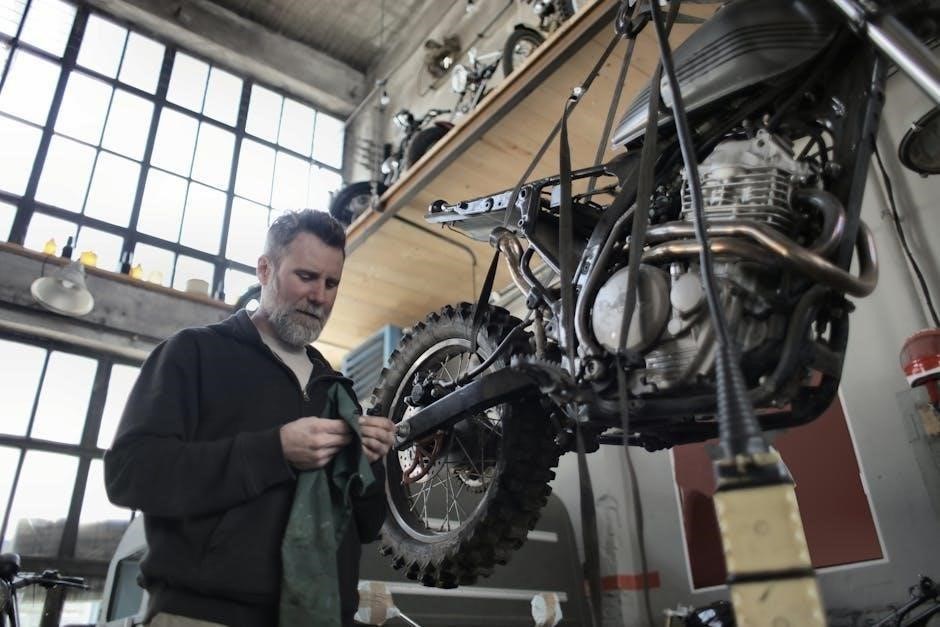centurion pro garage door manual
Welcome to the Centurion Pro Garage Door Manual. This guide provides essential information for the safe installation, operation, and maintenance of your garage door system. Follow the instructions carefully to ensure optimal performance and longevity of your Centurion Pro garage door.
1.1 Overview of the Centurion Pro Garage Door System
The Centurion Pro Garage Door System is a high-performance solution designed for durability and convenience. It includes advanced features like smart technology integration, energy-efficient operation, and noise reduction. The system is compatible with 433MHz radio controls, ensuring seamless remote functionality. Key components include the motor, door panels, and a user-friendly control panel. This system is engineered to provide reliable performance while maintaining a sleek, modern design. It is suitable for various garage configurations and offers customizable settings for optimal functionality.

1.2 Importance of Following the Manual Instructions
Adhering to the Centurion Pro Garage Door Manual is crucial for ensuring safety, proper installation, and optimal performance. The manual provides detailed guidelines to prevent accidents and guarantee the system functions as intended. By following the instructions, users can avoid potential risks, maintain warranty coverage, and extend the lifespan of the garage door. Correct installation and maintenance procedures outlined in the manual ensure smooth operation and prevent costly repairs. Always refer to the manual before performing any adjustments or repairs to guarantee safety and efficiency.

Safety Precautions and Guidelines
Always disconnect power before installation or repairs. Wear protective gear and ensure the garage door is securely supported. Follow all warnings in the manual to avoid accidents and ensure safe operation.
2.1 Essential Safety Measures Before Installation
Before installing your Centurion Pro garage door, ensure the area is clear of obstacles and children. Disconnect the power supply to avoid electrical hazards. Wear protective gloves and eyewear. Ensure the garage door is securely supported to prevent accidental falls. Check for any damaged components and replace them before proceeding. Always follow the manual’s instructions and adhere to local safety regulations. Proper preparation ensures a safe and successful installation process.
2.2 Safety Tips for Operating the Garage Door
Always ensure the garage door area is clear of people, pets, and objects before opening or closing. Never allow children to play with the remote control or operate the door unsupervised. Keep fingers and hands away from moving parts. Avoid standing directly under the door while it is in motion. Regularly inspect the door and opener for wear or damage. Ensure the door is fully closed during severe weather to prevent damage. Familiarize yourself with the emergency manual release feature in case of power failure or malfunctions.

Installation Instructions
Follow the step-by-step guide to install your Centurion Pro garage door. Ensure proper alignment and secure all tracks and brackets. Test the door’s operation after installation.
3.1 Step-by-Step Guide to Installing the Centurion Pro Garage Door
Begin by preparing all tools and components. Assemble the track system according to the manual’s instructions. Attach the door panels securely to the tracks, ensuring proper alignment. Next, mount the tracks to the garage frame, following the specified measurements. Install the motor and control system, connecting wires carefully. Do not connect power until instructed. Finally, test the door’s operation to ensure smooth functionality before completing the installation.
3.2 Troubleshooting Common Installation Issues
Common issues during installation include misaligned tracks, motor malfunctions, or incorrect wiring connections. Check that all bolts and screws are securely tightened and tracks are properly aligned. If the motor doesn’t respond, ensure the power is connected and the circuit breaker isn’t tripped. For wiring issues, verify connections match the manual’s diagram. If problems persist, consult the troubleshooting section or contact customer support. Always prioritize safety and refer to professional assistance if needed to avoid further complications.
Programming and Remote Control Setup
Learn how to program your remote control and set up your Centurion Pro garage door system. Follow step-by-step instructions to sync your remote with the motor unit and ensure secure operation.
4.1 How to Program the Remote Control
To program your Centurion Pro garage door remote control, start by pressing and holding the “Learn” button on the motor unit until the indicator light blinks. Next, press the desired button on your remote control and hold it until the light stops blinking. Release the button and test the remote to ensure it operates the garage door smoothly. Repeat the process for additional remotes if needed. Always ensure the remote is synchronized correctly for secure and efficient operation.
4.2 Adjusting Settings for Optimal Performance
Adjust the force settings to ensure smooth operation, testing with obstacles to confirm proper reversal. Modify opening and closing limits to achieve full range of motion without overextending. Fine-tune travel limits for accurate door positioning. Check sensitivity settings for appropriate obstacle detection. Set delay settings for automatic closing to balance convenience and security. Adjust the light timer for energy efficiency. Explore operating modes like energy-saving or silent options. Activate vacation mode for enhanced security. Check battery settings for reliable remote operation. Integrate smart features for scheduling and home automation. Methodically adjust each setting to optimize performance and convenience.
Maintenance and Repair Tips
Regular lubrication of moving parts ensures smooth operation. Inspect springs and cables for wear. Adjust door alignment for proper sealing. Replace worn-out rollers and hinges. Check sensors for alignment and clean them. Tighten loose screws and bolts. Test emergency release function monthly. Insulate the door for energy efficiency. Schedule professional servicing annually. Address minor issues promptly to prevent major repairs. Keep the door surface clean to maintain durability. Refer to the manual for specific maintenance schedules. Ensure all safety features are functioning correctly. Maintain proper garage door balance to reduce strain on the motor. Replace batteries in remotes and keypads as needed. Inspect the track for debris and clean it regularly. Check the weather seal for damage and replace if necessary. Lubricate the opener chain or belt every six months. Monitor noise levels and address unusual sounds immediately. Keep the garage door opener firmware updated. Test the door’s auto-reverse feature monthly. Inspect the safety sensors for proper alignment and function. Replace any damaged or worn-out parts promptly. Maintain proper tire pressure for smooth operation. Check and replace the air filter in the motor unit. Ensure all bolts and screws are tightened securely. Inspect the door’s insulation for gaps or damage. Lubricate the hinges and rollers every three months. Check the door’s balance by disconnecting the opener and manually moving it. Insulate the garage door to reduce heat loss and noise. Replace the remote control batteries every two years. Inspect the garage door tracks for misalignment and adjust as needed. Clean the photo-eye sensors with a soft cloth. Replace the garage door seal if it’s cracked or brittle. Lubricate the garage door springs every six months. Inspect the cables for frays and wear. Replace the garage door opener chain if it shows signs of wear. Check the door’s alignment with the frame and adjust if necessary. Lubricate the garage door hinges every three months. Inspect the opener’s gears for wear and tear. Replace the garage door rollers every five years. Check the door’s insulation for moisture damage. Lubricate the opener’s chain or belt every six months. Inspect the garage door tracks for dents and bends. Replace the opener’s circuit board if it’s malfunctioning. Check the door’s springs for tension and adjust if necessary. Inspect the opener’s motor for unusual noise. Replace the remote control if it’s not functioning properly. Lubricate the garage door’s pivot points. Inspect the opener’s sensors for proper function. Replace the door’s weather stripping if it’s damaged. Check the opener’s chain tension and adjust as needed. Inspect the door’s frame for any damage or rot. Lubricate the hinges and rollers every three months. Replace the opener’s remote control if it’s lost or damaged. Inspect the door’s alignment and adjust if necessary. Lubricate the opener’s gears every six months. Check the door’s balance by disconnecting the opener. Inspect the opener’s circuit board for any damage. Replace the door’s springs if they’re broken or worn. Lubricate the garage door’s moving parts every three months. Inspect the opener’s motor for proper function. Replace the door’s cables if they’re frayed or damaged. Check the opener’s chain for any signs of wear. Lubricate the door’s hinges and rollers regularly. Inspect the opener’s sensors for alignment and cleanliness. Replace the door’s seal if it’s cracked or brittle. Lubricate the opener’s chain or belt every six months. Inspect the door’s tracks for any debris or damage. Replace the opener’s remote control batteries every two years. Check the door’s alignment and adjust if necessary. Lubricate the garage door’s pivot points every three months. Inspect the opener’s gears for any wear or damage. Replace the door’s rollers every five years. Lubricate the opener’s motor every six months. Inspect the door’s springs for proper tension. Replace the opener’s circuit board if it’s malfunctioning. Check the door’s balance by manually moving it. Lubricate the garage door’s hinges and rollers. Inspect the opener’s chain for any signs of wear. Replace the door’s weather stripping if it’s damaged. Check the opener’s gears for proper function. Lubricate the door’s moving parts every three months. Inspect the opener’s sensors for alignment and cleanliness. Replace the door’s cables if they’re frayed or worn. Lubricate the opener’s chain or belt every six months. Inspect the door’s tracks for any misalignment. Replace the opener’s remote control if it’s not working. Check the door’s alignment and adjust as needed. Lubricate the garage door’s pivot points regularly. Inspect the opener’s motor for any unusual noise. Replace the door’s springs if they’re broken. Lubricate the opener’s gears every six months. Check the door’s balance by disconnecting the opener. Inspect the opener’s circuit board for any damage. Replace the door’s rollers every five years. Lubricate the garage door’s hinges and rollers. Inspect the opener’s chain for any wear or damage. Replace the door’s seal if it’s cracked. Lubricate the opener’s chain or belt every six months. Inspect the door’s tracks for any debris. Replace the opener’s remote control batteries every two years. Check the door’s alignment and adjust if necessary. Lubricate the garage door’s moving parts regularly. Inspect the opener’s gears for any wear. Replace the door’s cables if they’re damaged. Lubricate the opener’s motor every six months. Check the door’s springs for proper tension. Inspect the opener’s sensors for proper function. Replace the door’s weather stripping if necessary. Lubricate the opener’s chain or belt every six months. Inspect the door’s tracks for any misalignment. Replace the opener’s remote control if it’s not functioning. Check the door’s alignment and adjust as needed. Lubricate the garage door’s pivot points every three months. Inspect the opener’s motor for any damage. Replace the door’s springs if they’re worn out. Lubricate the opener’s gears every six months. Check the door’s balance by manually operating it. Inspect the opener’s circuit board for any issues. Replace the door’s rollers every five years. Lubricate the garage door’s hinges and rollers; Inspect the opener’s chain for any signs of wear. Replace the door’s seal if it’s damaged. Lubricate the opener’s chain or belt every six months. Inspect the door’s tracks for any debris or damage. Replace the opener’s remote control if it’s lost or damaged. Check the door’s alignment and adjust if necessary. Lubricate the garage door’s moving parts every three months. Inspect the opener’s gears for any wear or tear. Replace the door’s cables if they’re frayed. Lubricate the opener’s motor every six months. Check the door’s springs for proper tension. Inspect the opener’s sensors for alignment and cleanliness. Replace the door’s weather stripping if it’s cracked. Lubricate the opener’s chain or belt every six months. Inspect the door’s tracks for any misalignment. Replace the opener’s remote control batteries every two years. Check the door’s alignment and adjust as needed. Lubricate the garage door’s pivot points regularly. Inspect the opener’s motor for any unusual noise. Replace the door’s springs if they’re broken. Lubricate the opener’s gears every six months. Check the door’s balance by disconnecting the opener. Inspect the opener’s circuit board for any damage. Replace the door’s rollers every five years. Lubricate the garage door’s hinges and rollers. Inspect the opener’s chain for any wear or damage. Replace the door’s seal if it’s cracked or brittle. Lubricate the opener’s chain or belt every six months. Inspect the door’s tracks for any debris. Replace the opener’s remote control if it’s not functioning properly; Check the door’s alignment and adjust if necessary. Lubricate the garage door’s moving parts every three months. Inspect the opener’s gears for any wear. Replace the door’s cables if they’re frayed or damaged. Lubricate the opener’s motor every six months. Check the door’s springs for proper tension. Inspect the opener’s sensors for proper alignment. Replace the door’s weather stripping if it’s damaged; Lubricate the opener’s chain or belt every six months. Inspect the door’s tracks for any misalignment. Replace the opener’s remote control if it’s not working. Check the door’s alignment and adjust as
5.1 Regular Maintenance Tasks to Ensure Smooth Operation
Perform regular lubrication of hinges, rollers, and springs to maintain smooth operation. Inspect cables and springs for wear or damage. Check door alignment and adjust if necessary. Clean the track system to ensure proper movement. Tighten all bolts and screws periodically. Test safety features like auto-reverse to ensure they function correctly. Clean photo-eye sensors to prevent malfunction. Replace worn-out rollers and hinges. Check the door balance by disconnecting the opener. Lubricate the opener chain or belt every six months. Insulate the door for energy efficiency. Schedule annual professional servicing. Address minor issues promptly to prevent major repairs. Refer to the manual for specific maintenance schedules.

5.2 DIY Repairs for Common Garage Door Problems
Address squeaky noises by lubricating hinges and rollers with silicone-based spray. Tighten loose bolts and screws to ensure stability. If the door is misaligned, adjust the tracks slightly. Clean or replace faulty photo-eye sensors to restore proper function. For a stuck door, check for obstructions and ensure the track is clear. If the opener remote isn’t working, replace the batteries or reprogram it. For minor dents, use a rubber mallet to reshape the panel. Inspect cables for frays and replace them if necessary. Always disconnect power before attempting repairs. Refer to the manual for specific guidance and safety precautions.
Advanced Features of the Centurion Pro Garage Door
The Centurion Pro Garage Door offers smart technology integration, enabling remote control via smartphones. It features energy-efficient operation, noise reduction, and automatic locking for enhanced security and convenience.

Warranty and Support Information
6.1 Smart Technology Integration
The Centurion Pro Garage Door seamlessly integrates with smart technology, allowing users to control their garage door via a smartphone app. This feature enables remote access, real-time notifications, and voice command functionality through platforms like Amazon Alexa or Google Assistant. Smart integration ensures enhanced security, as users can monitor and operate their garage door from anywhere. The system also supports energy monitoring, providing insights into power consumption. This advanced technology offers convenience, improved safety, and effortless management of your garage door system.